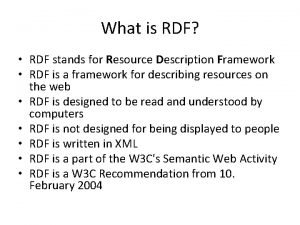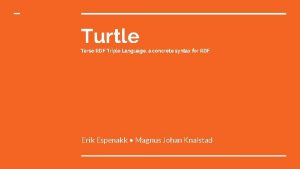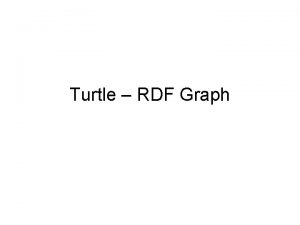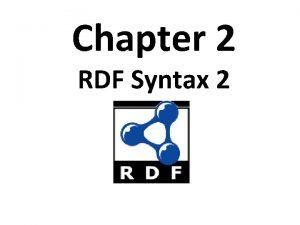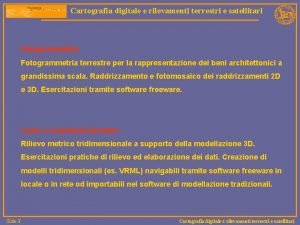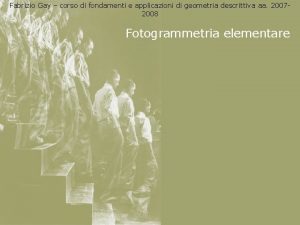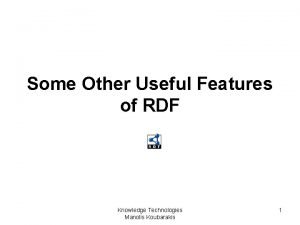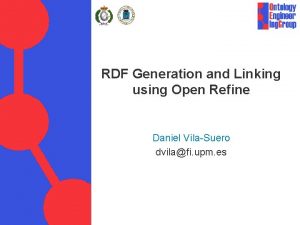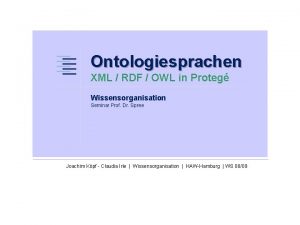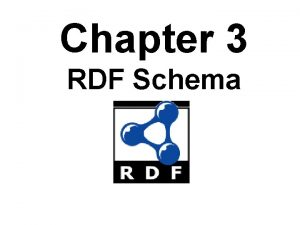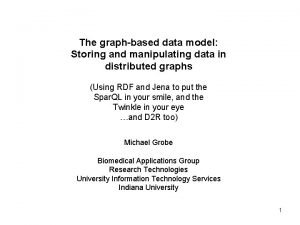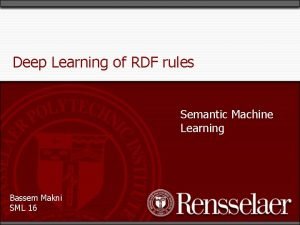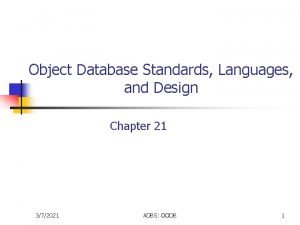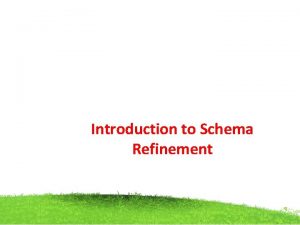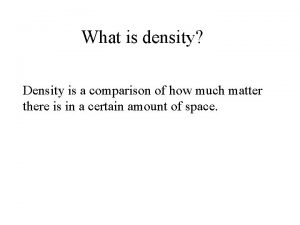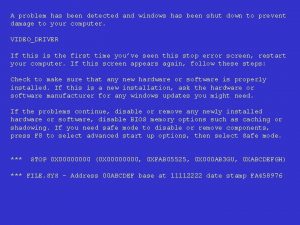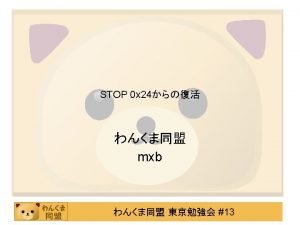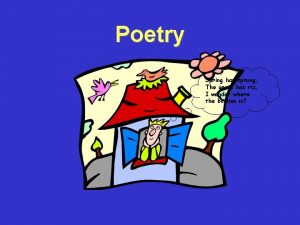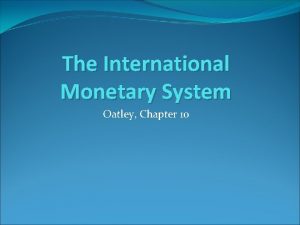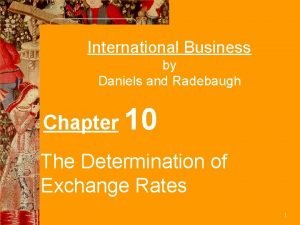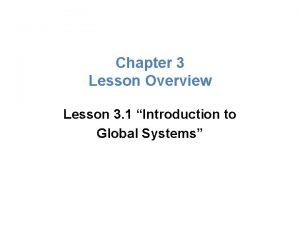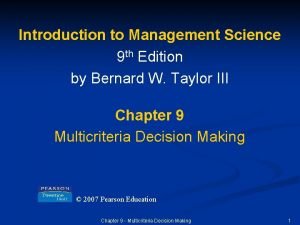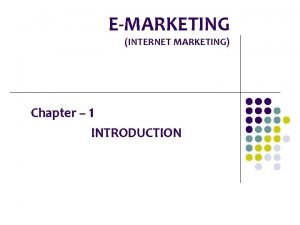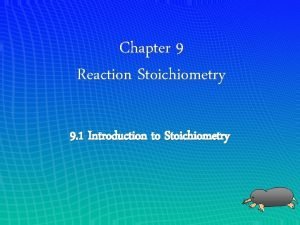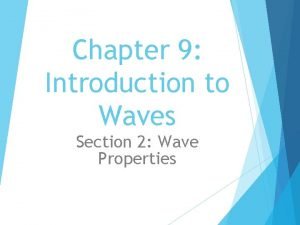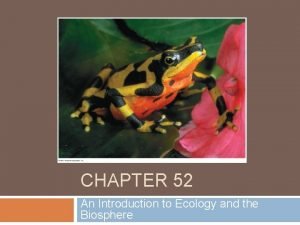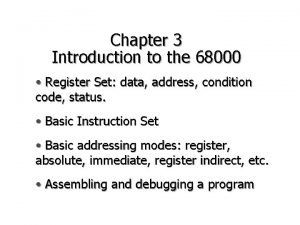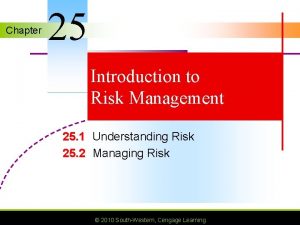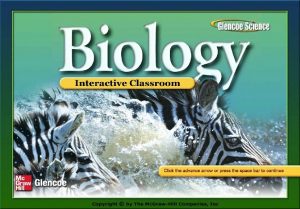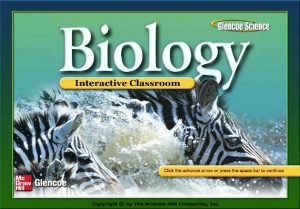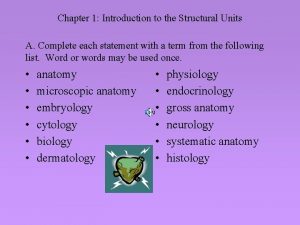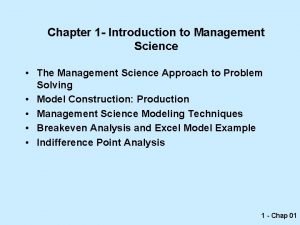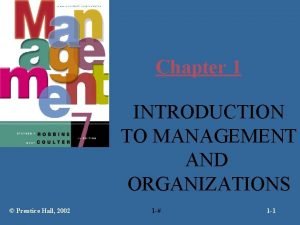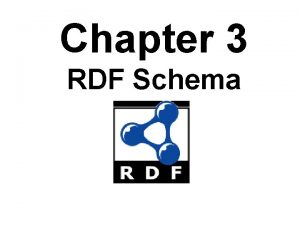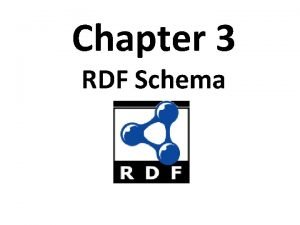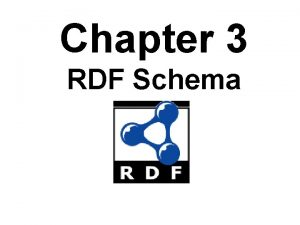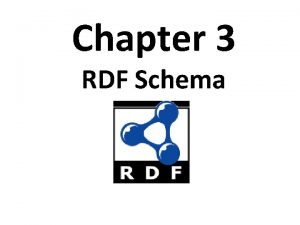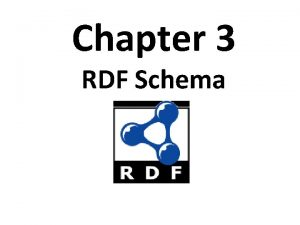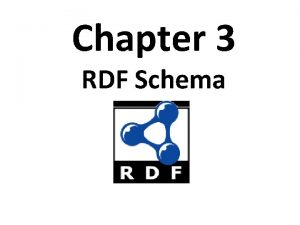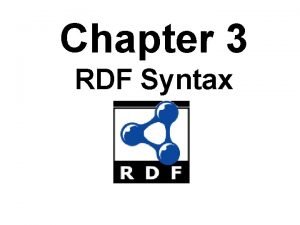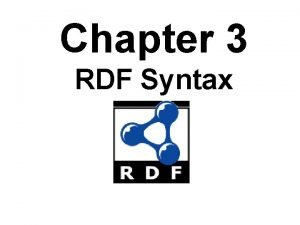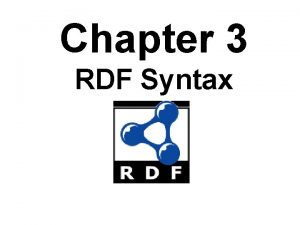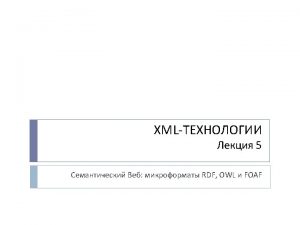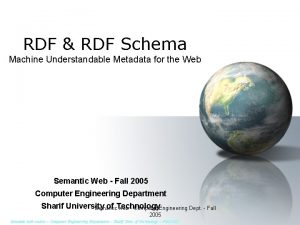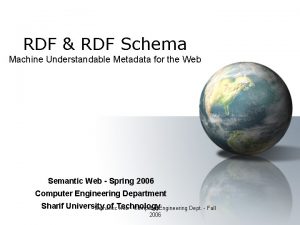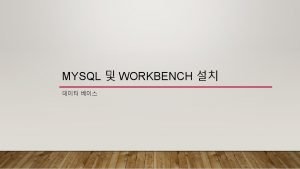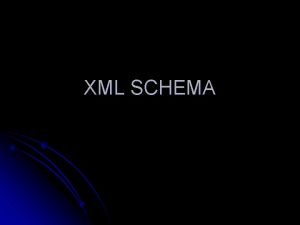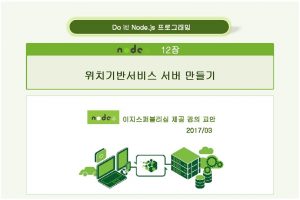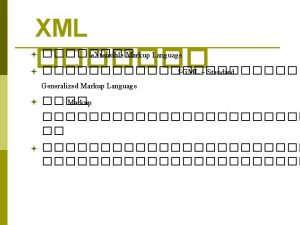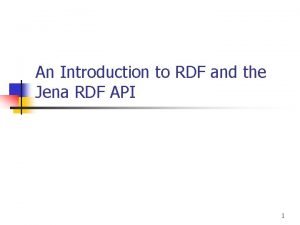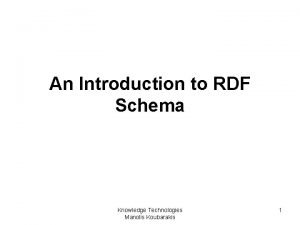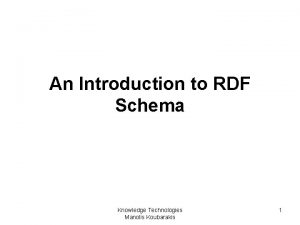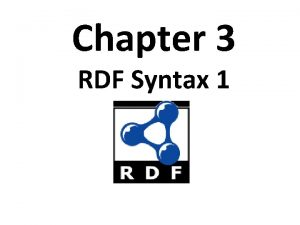Chapter 3 RDF Schema Introduction l RDF has













































- Slides: 45

Chapter 3 RDF Schema

Introduction l RDF has a very simple data model l RDF Schema (RDFS) enriches the data model, adding vocabulary & associated semantics for Classes and subclasses – Properties and sub-properties – Typing of properties – l Support for describing simple ontologies l Adds an object-oriented flavor l But with a logic-oriented approach and using “open world” semantics

RDFS is a simple KB Language Several widely used Knowledge-Base tools can import and export in RDFS, including Stanford’s Protégé KB editor

RDFS Vocabulary RDFS introduces the following terms, giving each a meaning w. r. t. the rdf data model l Terms for classes rdfs: Class – rdfs: sub. Class. Of l Terms for properties – rdfs: domain – rdfs: range – rdfs: sub. Property. Of l Special classes – rdfs: Resource – rdfs: Literal – rdfs: Datatype – l Terms for collections – rdfs: member – rdfs: Container. Membership. Property l Special properties – rdfs: comment – rdfs: see. Also – rdfs: is. Defined. By – rdfs: label

Modeling the semantics in logic l We could represent any RDF triple with a binary predicate in logic, e. g. type(john, human) – age(john, 32) – subclass(human, animal) – l But traditionally we model a class as a unary predicate human(john) – age(john, 32) – subclass(human, animal) –

Classes and Instances l. We distinguish between Concrete “things” (individual objects) in the domain: Discrete Math, Richard Chang, etc. – Sets of individuals sharing properties called classes: lecturers, students, courses etc. – l. Individual objects belonging to a class are referred to as instances of that class l. Relationship between instances and classes in RDF is through rdf: type l. Note similarity to classes and objects in an OO prog. language (but RDF classes stand for sets)

Classes are Useful Classes let us impose restrictions on what can be stated in an RDF document using the schema As in programming languages E. g. , A+1, where A is an array – Disallow nonsense from being stated by detecting contradictions – Allow us to infer a type of an object from how it is used -- like type inference in a programming language –

Preventing nonsensical Statements l. Discrete Math is taught by Calculus We want courses to be taught by lecturers only – Restriction on values of the property “is taught by” (range restriction) – l. Room ITE 228 is taught by Richard Chang Only courses can be taught – This imposes a restriction on the objects to which the property can be applied (domain restriction) –

Class Hierarchies l. Classes can be organized in hierarchies A is a subclass of B if and only if every instance of A is also an instance of B – We also say that B is a superclass of A – l Subclass graph needn’t be a tree – A class may have multiple superclasses l. In logic: subclass(p, q) p(x) => q(x) – subclass(p, q) ∧ p(x) => q(x) –

Domain and Range l The domain & range properties let us associate classes with a property’s subject and object l Only a course can be taught – domain(is. Taught. By, course) l Only an academic staff member can teach – range(is. Taught. By, academic. Staff. Member) l Semantics in logic: domain(pred, aclass)∧pred(subj, obj) => aclass(subj) – range(pred, aclass)∧pred(subj, obj) => aclass(obj) –

Property Hierarchies l. Hierarchical relationships for properties E. g. , “is taught by” is a subproperty of “involves” – If a course C is taught by an academic staff member A, then C also involves Α – l. The converse is not necessarily true – E. g. , A may be the teacher of the course C, or a TA who grades student homework but doesn’t teach l. Semantics in logic subproperty(p, q) ∧ p(subj, obj) => q(sub, obj) – e. g, subproperty(mother, parent), mother(p 1, p 2) => parent(p 1, p 2) –

RDF Schema in RDF l RDFS’s modelling primitives are defined using resources and properties (RDF itself is used!) l To declare that “lecturer” is a subclass of “academic staff member” Define resources lecturer, academic. Staff. Member, and sub. Class. Of – define property sub. Class. Of – Write triple (sub. Class. Of, lecturer, academic. Staff. Member) –

Core Classes l rdfs: Resource: class of all resources l rdfs: Class: class of all classes l rdfs: Literal: class of all literals (strings) l rdf: Property: class of all properties l rdf: Statement: class of all reified statements

Core Properties l rdf: type: relates a resource to its class The resource is declared to be an instance of that class l rdfs: sub. Class. Of: relates a class to one of its superclasses All instances of a class are instances of its superclass l rdfs: sub. Property. Of: relates a property to one of its superproperties

Core Properties l rdfs: domain: specifies domain of property P The class of those resources that may appear as subjects in a triple with predicate P – If domain not specified, any resource can be subject – l rdfs: range: specifies range of a property P The class of those resources that may appear as object in a triple with predicate P – If range not specified, any resource can be object –

Examples (in Turtle) : lecturer a rdfs: Class; rdfs: sub. CLass. Of : staff. Member. : phone a rdfs: Class; rdfs: domain : staff. Member; rdfs: range rdfs: Literal.

Relationships: Core Classes & Properties l rdfs: sub. Class. Of and rdfs: sub. Property. Of are transitive, by definition l rdfs: Class is a subclass of rdfs: Resource – Because every class is a resource l rdfs: Resource – is an instance of rdfs: Class rdfs: Resource is class of all resources, so it is a class l Every class is an instance of – For the same reason rdfs: Class

Subclass Hierarchy of RDFS Primitives rdfs: sub. Class. Of arrows represent the rdfs: sub. Class. Of relation

Instance Relationships of RDFS Primitives rdf: type rdf: type arrows represent the rdf: type relation

RDF and RDFS Property Instances rdf: type rdf: type arrows represent the rdf: type relation

Utility Properties l rdfs: see. Also relates a resource to another resource that explains it l rdfs: is. Defined. By: a subproperty of rdfs: see. Also that relates a resource to the place where its definition, typically an RDF schema, is found l rfds: comment. Comments, typically longer text, can be associated with a resource l rdfs: label. A human-friendly label (name) is associated with a resource

Data and schema Schema Data Syntactically it’s all just RDF. The data part only uses RDF vocabulary and the schema part uses RDFS vocabulary

RDF and RDFS Namespaces l The RDF, RDFS and OWL namespaces specify some constraints on the ‘languages’ – http: //www. w 3. org/1999/02/22 -rdf-syntax-ns# – http: //www. w 3. org/2000/01/rdf-schema# – http: //www. w 3. org/2002/07/owl# l Strangely, each uses terms from all three to define its own terms l Don’t be confused: the real semantics of the terms isn’t specified in the namespace files

RDF Namespace <rdf: RDF xmlns: rdf="http: //www. w 3. org/1999/02/22 -rdf-syntax-ns#" xmlns: rdfs="http: //www. w 3. org/2000/01/rdf-schema#" xmlns: owl="http: //www. w 3. org/2002/07/owl#" xmlns: dc="http: //purl. org/dc/elements/1. 1/"> <owl: Ontology rdf: about="http: //www. w 3. org/2000/01/rdf-schema#" dc: title="The RDF Schema vocabulary (RDFS)"/> <rdfs: Class rdf: about="http: //www. w 3. org/2000/01/rdf-schema#Resource"> <rdfs: is. Defined. By rdf: resource="http: //www. w 3. org/2000/01/rdf-schema#"/> <rdfs: label>Resource</rdfs: label> <rdfs: comment>The class resource, everything. </rdfs: comment> </rdfs: Class> …

RDF Namespace in turtle @prefix rdf: <http: //www. w 3. org/1999/02/22 -rdf-syntax-ns#>. @prefix rdfs: <http: //www. w 3. org/2000/01/rdf-schema#>. @prefix owl: <http: //www. w 3. org/2002/07/owl#>. @prefix dc: <http: //purl. org/dc/elements/1. 1/>. <http: //www. w 3. org/1999/02/22 -rdf-syntax-ns#> a owl: Ontology ; dc: title "The RDF Vocabulary (RDF)" ; dc: description "This is the RDF Schema for the RDF vocabulary defined in the RDF namespace. ". rdf: type a rdf: Property ; rdfs: is. Defined. By <http: //www. w 3. org/1999/02/22 -rdf-syntax-ns#> ; rdfs: label "type" ; rdfs: comment "The subject is an instance of a class. " ; rdfs: range rdfs: Class ; rdfs: domain rdfs: Resource.

RDF Namespace example rdf: Statement a rdfs: Class ; rdfs: sub. Class. Of rdfs: Resource ; rdfs: comment "The class of RDF statements. ". rdf: subject a rdf: Property ; rdfs: domain rdf: Statement ; rdfs: range rdfs: Resource. rdf: predicate a rdf: Property ; rdfs: domain rdf: Statement ; rdfs: range rdfs: Resource.

RDFS vs. OO Models l. In OO models, an object class defines the properties that apply to it – Adding a new property means modifying the class l. In RDF, properties defined globally and not encapsulated as attributes in class definitions – We can define new properties w/o changing class – Properties can have properties : mother rdfs: sub. Property. Of : parent; rdf: type : Family. Relation. – But: can’t narrow domain & range of properties in a subclass

Example @prefix rdf: <http: //www. w 3. org/1999/02/22 -rdf-syntax-ns#>. @prefix rdfs: <http: //www. w 3. org/2000/01/rdf-schema#>. @prefix bio: <http: //example. com/biology#>. bio: Animal a rdfs: Class. bio: offspring a rdfs: Property; rdfs: domain bio: Animal; rdfs: range bio: Animal. bio: Human rdfs: sub. Class. Of bio: Animal. bio: Dog rdfs: sub. Class. Of bio: Animal. : fido a bio: Dog. : john a bio: Human; bio: offspring : fido. There is no way to say that the offspring of humans are humans and the offspring of dogs are dogs.

Example Bio: child rdfs: sub. Property. Of bio: offspring; rdfs: domain bio: Human; rdfs: range bio: Human. Bio: puppy rdfs: sub. Property. Of bio: offspring; rdfs: domain bio: Dog; What do we know after each of the last two triples rdfs: range bio: Dog. are asserted? : john bio: child : mary. : fido bio: puppy : rover. Suppose we also assert: • : john bio: puppy : rover • : john bio: child : fido

Not like types in OO systems l Classes differ from types in OO systems in how they are used – They are not constraints on well-formedness l Lack of negation and open world assumption RDF+RDFS makes detecting contradictions impossible! – Can’t say that Dog and Human are disjoint classes – Not knowing any individuals who are both doesn’t mean it’s not possible in

No disjunctions or union types What does this mean? bio: Human rdfs: sub. Class. Of bio: Animal. bio: Cat rdfs: sub. Class. Of bio: Animal. bio: Dog rdfs: sub. Class. Of bio: Animal. bio: has. Pet a rdfs: Property; rdfs: domain bio: Human; rdfs: range bio: Dog; rdfs: range bio: Cat.

No disjunctions or union types What does this mean? Bio: Human rdfs: sub. Class. Of bio: Animal. bio: Cat rdfs: sub. Class. Of bio: Animal. Bio: Dog rdfs: sub. Class. Of bio: Animal. bio: has. Pet a rdfs: Property; Consider adding: : john bio: has. Pet : spot rdfs: domain bio: Human; rdfs: range bio: Dog; rdfs: range bio: Cat.

No disjunctions or union types What does this mean? bio: Human rdfs: sub. Class. Of bio: Animal. bio: Cat rdfs: sub. Class. Of bio: Animal. bio: Dog rdfs: sub. Class. Of bio: Animal. bio: has. Pet a rdfs: Property; : john bio: has. Pet : spot => rdfs: domain bio: Human; : john a bio: Human, rdfs: range bio: Dog; bio: Animal. rdfs: range bio: Cat. : spot a bio: Dog, bio: Cat, bio: Animal.

What do we want to say? l Many different possibilities Only a dog or cat can be an object of has. Pet property – Dogs and cats and maybe other animals are possible as pets – Dogs and cats and maybe other things, not necessarily animals, are possible as pets – All dogs and all cats are pets – It’s possible for some dogs and some cats to be pets – l Not all of these can be said in RDF+RDFS l We can express all of these in OWL (I think)

What do we want to say? animal property subclass pet subclass human has. Pet subclass dog subclass range cat domain

What do we want to say? animal property subclass pet subclass human has. Pet subclass dog john subclass range cat has. Pet domain spot

What do we want to say? animal property subclass pet subclass human has. Pet subclass dog subclass range cat All dogs are pets has. Pet john All cats are pets All pets are animals domain : john bio: has. Pet : spot => : john a bio: Human, spot bio: Animal. : spot a bio: Pet, bio: Animal.

What do we want to say? animal property subclass pet subclass human has. Pet subclass dog All dogs are pets All cats are pets All pets are animals subclass range cat domain : john bio: has. Pet : spot => : john a bio: Human, bio: Animal. : spot a bio: Pet, bio: Animal.

What do we want to say? animal property subclass pet subclass has. Pet subclass human dog type subclass range cat domain type john has. Pet type spot

Classes and individuals are not disjoint l In OO systems a thing is either a class or object – Many KR systems are like this also l Not so in RDFS bio: Species rdf: type rdfs: Class. bio: Dog rdf: type rdfs: Species; rdfs: sub. Class. Of bio: Animal. : fido rdf: type bio: Dog. • rdf: type links an individual to a class it belongs to • rdfs: sub. Class links a class to a super-class it is part of l Adds richness to language but causes problems In OWL DL you can’t do this – OWL has it’s own notion of a Class, owl: Class –

Inheritance is simple l No defaults, overriding, shadowing l What you say about a class is necessarily true of all sub-classes l A class’s properties are not inherited by its members – Can’t say “Dog’s are normally friendly” or even “All dogs are friendly” – Meaning of the Dog class is a set of individuals – Sets cannot be friendly

Set Based Model Theory Example World Model Interpretation Daisy is. A Cow kind. Of Animal Mary is. A Person a Person kind. Of Animal Z 123 ABC is. A Car b Mary drives Z 123 ABC {. . . list of facts about individuals. . . }

Is RDF(S) better than XML? Q: For a specific application, should I use XML or RDF? A: It depends… l l XML's model is – a tree, i. e. , a strong hierarchy – applications may rely on hierarchy position – relatively simple syntax and structure – not easy to combine trees RDF's model is – a loose collections of relations – applications may do “database”-like search – not easy to recover hierarchy – easy to combine relations in one big collection – great for the integration of heterogeneous information

RDFS too weak to describe resources in detail – No localised range and domain constraints Can’t say range of has. Child is person when applied to persons and elephant when applied to elephants – No existence/cardinality constraints Can’t say all instances of person have a mother that is a person, or that persons have exactly two parents – No transitive, inverse or symmetrical properties Can’t say is. Part. Of is a transitive property, has. Part is the inverse of is. Part. Of or that touches is symmetrical We need RDF terms providing these and other features: this is where OWL comes in

RDF Conclusions l Simple data model based on a graph, independent of serializations (e. g. , XML or N 3) l Has a formal semantics providing a dependable basis for reasoning about the meaning of RDF expressions l Has an XML serialization, can use XML schema datatypes l Open world assumption: anyone can make statements about any resource l RDFS adds vocabulary with well defined semantics (e. g. , Class, sub. Class. Of, etc. ) l OWL addresses some of RDFS’s limitations adding richness (and complexity)
 Ontology schema
Ontology schema What is rdf?
What is rdf? Subjekt predikat objekt
Subjekt predikat objekt Syntax
Syntax Rdf list example
Rdf list example Rdf raddrizzamento geometrico
Rdf raddrizzamento geometrico Rdf raddrizzamento download
Rdf raddrizzamento download Who made this statement
Who made this statement Openrefine rdf extension
Openrefine rdf extension Rdf owl
Rdf owl Rdf
Rdf Rdf
Rdf Ontology rdf
Ontology rdf Bby learning network
Bby learning network Mapping eer to odb schema
Mapping eer to odb schema Introduction to schema refinement
Introduction to schema refinement Frank has an eraser
Frank has an eraser A problem has been detected
A problem has been detected Windows a problem has been detected
Windows a problem has been detected Spring has sprung, fall has fell poem
Spring has sprung, fall has fell poem Every picture has a story and every story has a moment
Every picture has a story and every story has a moment Let him who has ears
Let him who has ears Essay structure introduction
Essay structure introduction Has the exchange rate changed chapter 10
Has the exchange rate changed chapter 10 Has the exchange rate changed chapter 10
Has the exchange rate changed chapter 10 Chapter 3 lesson 1 introduction to global systems
Chapter 3 lesson 1 introduction to global systems Operation management objectives
Operation management objectives Introduction to management science chapter 5 solutions
Introduction to management science chapter 5 solutions Marine ecology
Marine ecology Introduction to e marketing
Introduction to e marketing Chapter 9 review stoichiometry section 1
Chapter 9 review stoichiometry section 1 Chapter 9 introduction to waves
Chapter 9 introduction to waves Chaparral climograph
Chaparral climograph Research chapter 3
Research chapter 3 Chapter 3 introduction
Chapter 3 introduction Pure risk example
Pure risk example Chapter 24 section 3 sponges and cnidarians
Chapter 24 section 3 sponges and cnidarians Chapter 21 introduction to risk management
Chapter 21 introduction to risk management Chapter 19 protists worksheet answers
Chapter 19 protists worksheet answers Chapter 1 introduction to the structural units
Chapter 1 introduction to the structural units Challenge word building medical terminology
Challenge word building medical terminology Introduction to management science chapter 1 solutions
Introduction to management science chapter 1 solutions Introduction to management and organizations
Introduction to management and organizations Human resource management chapter 1
Human resource management chapter 1 Chapter 1 introduction to human resource management
Chapter 1 introduction to human resource management Chapter 1 introduction to human anatomy and physiology
Chapter 1 introduction to human anatomy and physiology

